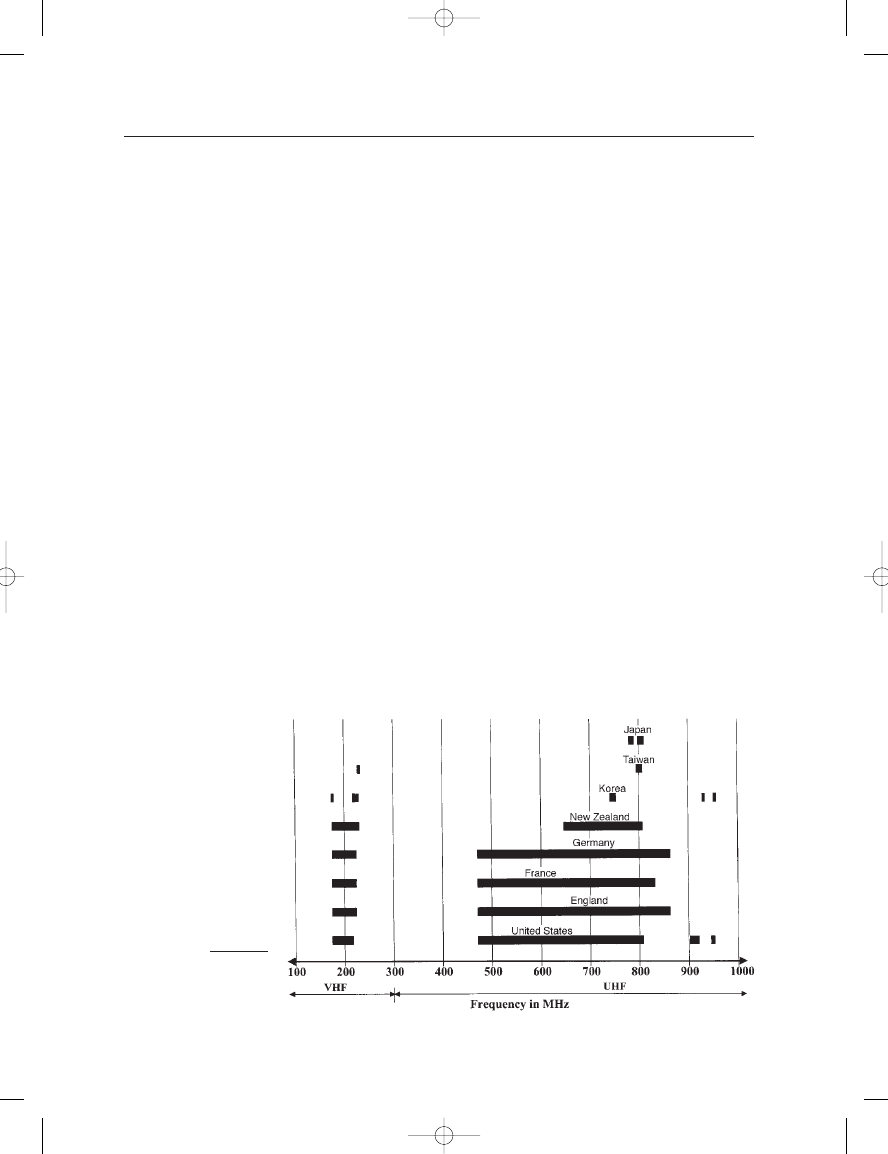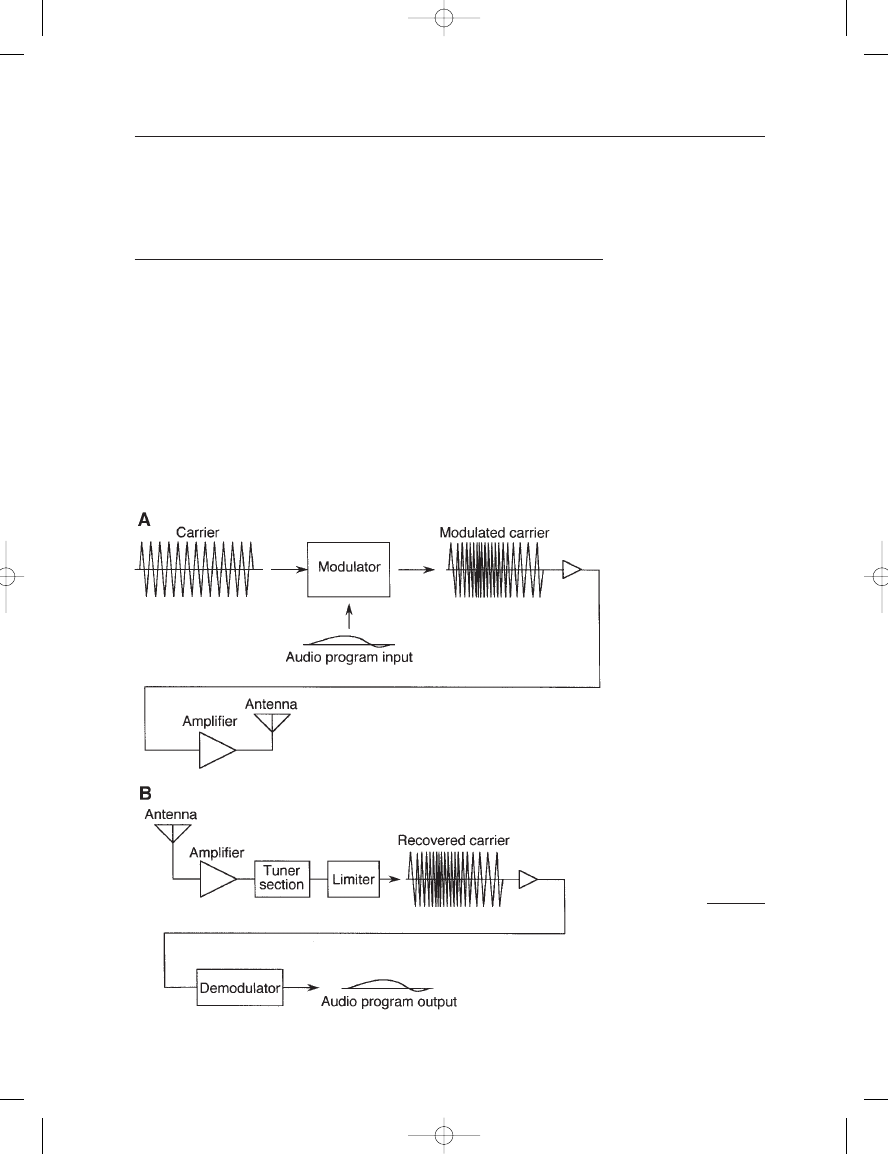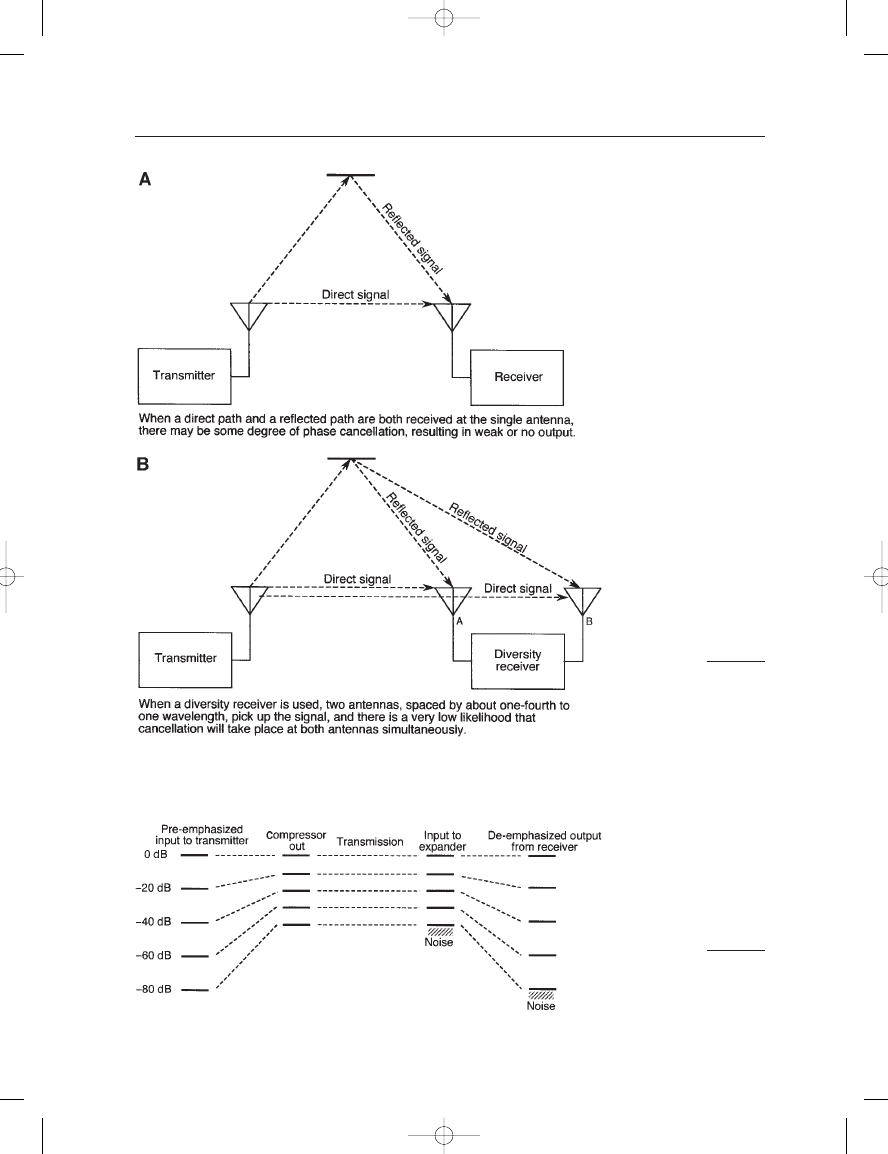ВУЗ: Казахская Национальная Академия Искусств им. Т. Жургенова
Категория: Книга
Дисциплина: Не указана
Добавлен: 03.02.2019
Просмотров: 17289
Скачиваний: 51

2. UHF (ultra-high frequency) range:
Low band: 450–806 MHz
High band: 900–952 MHz
The FCC gives priority to primary users, such as TV, radio, and com-
mercial communications activities such as cellular telephones, pagers,
and two-way radio applications. Wireless microphone application is
considered a secondary activity, and as such is not allowed to interfere
with primary activities. On the other hand, users of wireless micro-
phones are often subjected to interference from primary users and must
find their own solutions to these problems through the choice of more
appropriate, trouble-free operating frequencies.
In the US, a manufacturer or distributor of wireless microphone
systems must obtain a license from the FCC to sell the equipment, but
it is the responsibility of the final user/purchaser to observe and follow
all recommendations regarding proper use of the equipment. The alloca-
tion of specific frequency bands varies widely around the world and
within given countries, and the user must rely on good advice from both
manufacturer and dealer in purchasing the correct equipment for a given
application in a specified location.
Regarding overall quality of performance, the UHF range is preferred
in that it provides excellent line-of-sight reception within a given venue
with minimum radiation beyond the normal architectural confines of that
venue.
In the future, wireless microphone operations will have to coexist
with the demands of digital television and expansion of other classes of
communication. Both manufacturers, specifiers and users of wireless
products must keep abreast of all developments and restrictions in these
areas. Figure 9–1 shows some typical international frequency allotments
9: Overview of Wireless Microphone Technology
143
FIGURE 9–1
Some international wireless
frequency allotments. (Data
courtesy of Shure Inc.)
Earg_09.qxd 14/9/04 2:46 PM Page 143

for wireless microphone activity (Vear, 2003). A more comprehensive
listing is given in Ballou (2002).
TRANSMISSION PRINCIPLES
Wireless microphones work on the principle of FM transmission, as
shown in Figure 9–2A. A carrier at the assigned VHF or UHF frequency
is modulated by the audio program and sent to an RF amplifier contained
in the microphone case itself or in a “body pack” worn by the user. The
RF signal is propagated through space by a transmitter operating in the
power range of 10–50 mW. For UHF transmission the radiating antenna
can be housed in the lower portion of the microphone case. The antenna
for the bodypack is usually in the form of a short wire that hangs exter-
nally from the case.
Signal reception is shown in Figure 9–2B. Here, the RF signal is ampli-
fied and amplitude-limited to reduce static interference; the recovered
THE MICROPHONE BOOK
144
FIGURE 9–2
Principle of FM
transmission and reception:
simplified block diagram
of a transmitter (A);
simplified block diagram
of a receiver (B).
Earg_09.qxd 14/9/04 2:46 PM Page 144

carrier is then demodulated to produce audio output at the receiving end
of the system.
The simple system shown in Figure 9–1 has two major problems:
the potential loss of signal due to multiple reflections from transmitter to
receiver as the performer moves about the stage, and the susceptibility
to noise due to the low radiated power and low modulation index of the
transmitter as mandated by FCC standards and the requirements for
minimal interference with adjacent channels.
Diversity reception is used to overcome the multiple reflection prob-
lem, and a combination of signal companding (complementary compres-
sion and expansion) with pre- and post-equalization is used to reduce
noise.
DIVERSITY RECEPTION
With a single receiving antenna there exists the possibility that primary and
reflected carrier signals will arrive at the receiving antenna out-of-phase,
causing a momentary dropout of the carrier, as shown in Figure 9–3A. This
can be substantially avoided through the use of diversity reception. In
diversity reception there are two receiving antennas which are spaced by a
distance between one-quarter the carrier wavelength and one carrier wave-
length, and this reduces the likelihood of signal cancellation. The equation
relating radiated wavelength to frequency is:
wavelength (
) c/f
(9.1)
where
(Greek letter lambda) is wavelength, c is the speed of radio
waves (300,000,000 meters per second), and f is the frequency in Hz.
In the frequency range of 900 MHz, carrier wavelength is in the
range of about 3
10
8
to 9
10
8
meters (about 13 in), so an antenna
spacing of about 8–35 cm (3–13 in) can be used to substantially reduce
carrier cancellation at the antennas. This is shown in Figure 9–3B, with
the two receiving antennas (labeled A and B in the figure). Most modern
diversity receivers are of the so-called “true diversity” type, in which the
signals picked up by both antennas are simultaneously demodulated by
two separate receivers so that the switching function from one to the
other, depending on signal strength, is virtually instantaneous and free of
any switching noises.
SIGNAL COMPRESSION AND EXPANSION
To reduce the basic noise floor of the relatively narrow deviation FM
transmission system used with wireless microphones, complementary
signal compression and expansion, known as compansion, are used.
Figure 9–4 shows, in effect, how this works. The input signal varies over
a range of 80 dB and is compressed in the transmitting circuitry to occupy
a range of about 40 dB. After demodulation the signal is expanded by
40 dB to restore the original dynamic range.
9: Overview of Wireless Microphone Technology
145
Earg_09.qxd 14/9/04 2:46 PM Page 145

THE MICROPHONE BOOK
146
FIGURE 9–3
Diversity reception; single
receiving antenna (A); dual
(diversity) receiving antenna
reception (B).
FIGURE 9–4
Principle of operation of
signal companding
(compression-expansion).
Earg_09.qxd 14/9/04 2:46 PM Page 146

Companding is normally coupled with complementary signal pre-
emphasis and de-emphasis in order to minimize the audibility of noise
floor modulation by the complementary gain shifts. Typical fixed pre-
and de-emphasis curves are shown in Figure 9–5.
Considering the combined effects of diversity reception, companding,
and complementary pre- and de-emphasis, the subjective dynamic range
of a wireless microphone channel is in the range of 100 dB, considering
an A-weighted noise floor as measured under no-signal conditions.
TRANSMITTER UNITS
There are two basic transmitter units: the handheld microphone and the
body pack. These are shown in Figure 9–6 along with a receiving unit.
The microphone transmitter is convenient for most applications, and a
number of manufacturers provide a basic body on which a chosen micro-
phone capsule assembly can be fitted.
For those applications where the microphone must be concealed
(drama and musical shows), or where the user demands the freedom of
both hands, the body pack is used. The body pack is worn by the user,
normally in a pocket or strapped to the user’s belt. A thin wire connects
a standard tie-tack microphone to the body pack. Most body packs also
have a line input option for use in picking up amplified instruments
which may be carried around on-stage.
The transmitter’s antenna wire must hang free in order to ensure
proper operation. Those systems operating in the UHF high band will
require only about an 8 cm (3 in) antenna, and these are often built
directly into the microphone transmitter.
OPERATIONAL CONTROLS
THE TRANSMITTER
A transmitter of either type will normally have the following controls
(the nomenclature may vary slightly from one manufacturer to another):
1. Frequency selection. This is fixed inside the transmitter and is not
readily accessible to the user.
9: Overview of Wireless Microphone Technology
147
FIGURE 9–5
Typical HF pre-emphasis
(A) and de-emphasis (B)
curves used with wireless
microphones.
Earg_09.qxd 14/9/04 2:46 PM Page 147